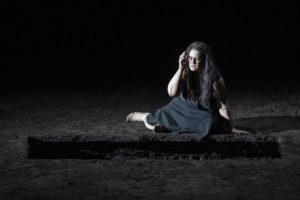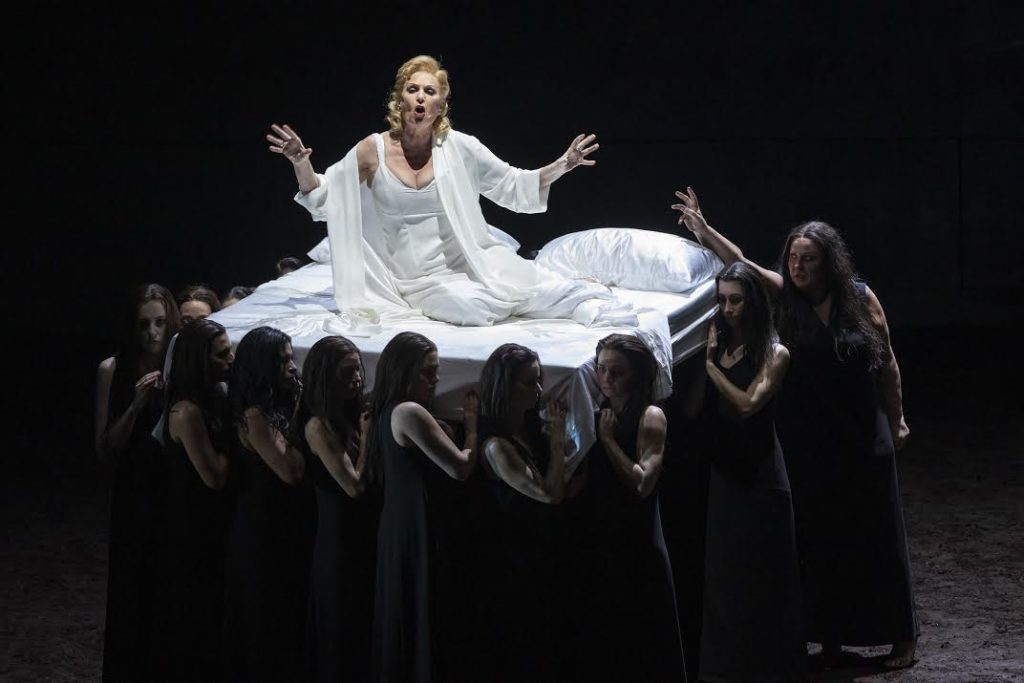
Palau de les Arts 2019-20 Review: Elektra
Irene Theorin Delivers A Masterclass in Dramatic Singing in Robert Carsen’s Fantastic Production
By Mauricio Villa(Credit: Miguel Lorenzo / Mikel Ponce)
Richard Strauss’ “Elektra,” one of the most audacious and darkest operas in the entire repertory, is a massive undertaking for any opera company. In the case of the Palau de Les Arts, the Robert Carsen production of the gripping opera was presented with great intensity further amplified by the appearance of Irene Theorin in the title role.
Opening night was an undeniable success.
Thirst for Vengeance
Irene Theorin has stablished herself as one of the best dramatic sopranos of the last two decades; with a round velvet sound, a potent voice whose timbre is equal throughout the whole register, and unbelievable top ringing notes; Theorin has made Isolde, Brünnhilde and Turandot her signature roles, singing them all over the world with great success. But we also must add Elektra to the list, as she proved in Valencia by giving a terrific psychotic personification of this demented character with thirst of vengeance, all while using her vast vocal resources to to enhance the dramatic projection of such a complex character and music.
Elektra is a hard role to sing. She is on stage during the whole opera, even when she is not singing. Furthermore, what she does sing covers the entire range of a dramatic soprano from low A flat to high C. While the tessitura of the role lies in the middle of the voice, it demands a powerful sound which can surpass the dense orchestral sound that Strauss conceived, by emitting strong high Gs and As while the orchestra is at its strongest. Moreover, the soprano must to several high B flats and high Cs and sing well below the stave on several other occasions. Theorin has the voice to accomplished such high demands, the stamina to maintain the vocal and mental catharsis of Elektra, the potency to project the voice over the orchestra ( with just a few difficulties in the middle register), and above all a beautiful sound.
She began her first intervention and monologue “Allein! Weh, ganz allein” gently, looking for plain sounds and giving a strong sense of psychosis and mental unbalance while lying on the floor. It was when she calls her father for the very first time, “Agamenon, Wo bist du, Vater?” that she made the first crescendo from a pianissimo F to a dramatic sustained note. The second time she clamors for her father, “Agamenon, Vater,” she unleashed her torrential sound while still playing with the dynamics with several jumps to high B flats; her first high C on “Grab so könig liche” was thunderous and effective.
After such a hard long scene, her interventions during the consequent duet with Chrytsothemis are short but still follow the same written pattern: strongly syllabical and with jumps to high B flats. Theorin held onto the cynicism of the moment by emitting harsh sounds on “Träumst du, Mutter?” and “Ich sagte doch: ein Mann!” This all led to a big outburst of anger and fury in her final intervention “Was bluten muB?” where the tessitura remains on several G and A flats, before reaching the second and final high C on “Der jauchzt und kannsichseines lebens freun” and ending on a high strong long B flat; Theorin sang all of this effortlessly and was clearly more focused on the mental stability and strong emotions of her role. She took the listener on the emotional journey of Elektra, making you forget how hard this music is to sing.
Though she became more lyrical for a moment when she tries to convince Chrysothemis to murder her mother and stepfather, she went back to an aggressive singing style when her pleads were refused. Again, Theorin produced forceful sounds to color her lines in an astonishing dramatic way, keeping the voice in good position to hit several high B flats throughout this scene.
It is during her scene with Orest that the vocal and orchestral writing changes drastically to become utterly lyrical, with long legato lines on the voices and the strings, as one melody melts into the next one to create a sea of emotional melodies. It is during her long intervention “Orest! Orest!” that Theorin delineated glorious legato lines with wonderful crescendos and a clever use of mezza voce; she was constantly looking for different ways to colored the repeating “selig der” at the end of the scene, giving a deeply emotional interpretation of what probably is the most beautiful part of this dark opera.
Her incarnation of the title role was magisterial, creating a great atmosphere of tension and suspense which Carsen directed very wisely to avoid the typical histrionic and profusely over-acted interpretation. That she accomplished all the vocal feats with such a demanding physical staging (at one point she has to bring Agammemnon’s body out of his grave and in another she has to hit the ground with the axe) only amplified the greatness of the interpretation.

(Credit: Miguel Lorenzo / Mikel Ponce)
Luxurious Interpretations
Doris Soffel gave a luxurious interpretation of Klytämnestra, dressed as a Hollywood actress in a white satin night gown and singing most of the scene on her bed (this served as a metaphor of her sin as she killed her husband to marry Aegisth). As such, her interpretation was dominated by contention, making this tortured and remorseful character deeply unstable and creating a suffocating tension between her and Elektra.
Soffel showed the control of her powerful chest register and strong middle range though there was noticeable weakness in her upper register with the few high B flats she took on sounding distant and swallowed. That said, her interpretation of the line “ Est ist kein wort, est ist kein Schmerz…” was hair-raising due to her use of dynamics to color this moment with anguish, remorse and despair.
American soprano Sara Jakubiak portrayed Elektra’s sister Chrysothemis, lyrical part full of long melting melodies to confront the atonality and aggressiveness of Elektra’s writing. It has an uncomfortable tessitura which is constantly ascending to high B naturals and while Jakubiak showed her potent and clean high notes, she had problems with projecting her voice over the big orchestration while singing in the middle register. She was passionate and convincing in “Kinder will auch leben!” which marks the main melody of her first intervention and acted as a great counterpart to Theorin’s psychotic performance.
Orest, the last principal character of the plot, was sung by the Australian bass-baritone Derek Welton, whose attractive dark timbre fulfilled this heroic and lyrical music. The tessitura of this role lies mostly in the middle register and the orchestration becomes lyrical and fluid too. Therefore the difficulties of this short role lies in the fluidity of the phrases which Welton sang with extreme beauty and style, creating a noble character.
The rest of the roles, as well as the chorus, only have small appearances, supporting the main roles throughout the opera. But all of them had to fight to be heard over the strong caudal sound of the orchestra which Marc Albrecht conducted with determination and detail; he was particularly attentive of the wind and brass sections. But given the acoustical challenges this particular hall presents and the opera’s potent orchestration, he should have found more balance between the ensemble and the soloists’ voices because most of them sounded distant or completely disappeared in the fortes. Even Theorin, whose voice is big enough, had problems in the middle register everytime the orchestra exploded with forte sound. In making the orchestra loud, Albrecht did not make the music more powerful but dismissed the dramatic characterization of the voices.

(Credit: Miguel Lorenzo / Mikel Ponce)
Master Through and Through
There is no doubt that Robert Carsen is one of the best stage directors nowadays and this “Elektra” came from a co-production between Paris Opera, Maggio Musicale Fiorentino and Tokyo Opera Nomori.
For the Strauss work, Carsen decided to create a simple enclosed and claustrophobic grey space, with dancers appearing as the alter ego of Elektra, usually imitating her movements in unison or multiplying the action.
Then there is a clever use of the light to reflect the psychology of the characters and enhance the drama. Carsen employs mostly strong white light to mark circles around the characters or to project their shadows on the grey walls. From a wardrobe standpoint, there is a wise contrast between black, which defines Elektra, the dancers, and most characters, with a pure white which Klytämnestra and Aegisth wear to underline the conflict of the opera.
Every detail is meaningful and is clearly aimed at creating a whole fusion between the bodies, the sets, the lighting and the costumes. And that goes without mentioning some staging choices. There are superb moments like Elektra grabbing Agamenon’s naked and bloody corpse out of his grave and holding him tenderly before he is lifted away by the dancers. Later in the opera, as she dances about her victory, it is Elektra who is lifted and carried around the stage over the dancers’ heads creating. Another visual motif that Carsen employs at the beginning and end of the opera features Elektra lying on her side in the middle of the stage, illuminated by a strong circle of white light.
The void which opens during Elektra’s first monologue, and acts as Agamemnon’s grave, swallows everything: Klytämnestra enters the stage in a white bed carried by the dancers, but at the end of her scene her bed and herself disappeared through the hole. It was quite impressive to see the 20 female dancers around the abyss holding axes between their backs and smashing the ground in unison as Orest kills his stepfather.
This was a truly dark and powerfully theatrical production that was warmly applauded by the audience, something very unusual today when it comes to truly modern concepts. But how could it be any different when there is a strong cast headlined by such a dominant singer as Irene Theorin?



